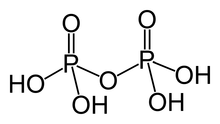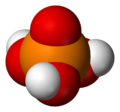Phosphoric acids and phosphates

In


Removal of
These acids, together with their
Acids
Phosphoric acid
The simplest and most commonly encountered of the phosphoric acids is
Oligophosphoric and polyphosphoric acids

Two or more orthophosphoric acid
For example, pyrophosphoric, triphosphoric and tetraphosphoric acids can be obtained by the reactions
The "backbone" of a polyphosphoric acid molecule is a chain of alternating P and O atoms. Each extra orthophosphoric unit that is condensed adds 1 extra H (hydrogen) atom, 1 extra P (phosphorus) atom, and 3 extra O (oxygen) atoms. The general formula of a polyphosphoric acid is Hn+2PnO3n+1 or HO[−P(O)(OH)−O−]nH.
Polyphosphoric acids are used in
Metaphosphoric acid
Metaphosphoric acid (HPO3) is a colorless, vitreous, deliquescent solid, density 2.2 to 2.5 g/cc, which sublimes upon heating. It is soluble in ethanol.[4]
Cyclic phosphoric acids

Phosphoric acid units can be bonded together in rings (cyclic structures). The simplest such compound is trimetaphosphoric acid or cyclo-triphosphoric acid having the formula H3P3O9. Its structure is shown in the illustration. Since the ends are condensed, its formula has one less H2O (water) than tripolyphosphoric acid.
The general formula of a phosphoric acid is Hn−2x+2PnO3n−x+1, where n is the number of phosphorus atoms and x is the number of fundamental cycles in the molecule's structure; that is, the minimum number of bonds that would have to be broken to eliminate all cycles.
-
Tetrapolyphosphoric acid
H6P4O13 -
Trimetaphosphoric acid
H3P3O9 -
Phosphoric anhydride
P4O10
The limiting case of internal condensation, where all oxygen atoms are shared and there are no hydrogen atoms (x = n+2/2) is an
Phosphates
Removal of the hydrogen atoms as protons H+ turns a phosphoric acid into a phosphate anion. Partial removal yields various hydrogen phosphate anions.
Orthophosphate
The anions of orthophosphoric acid H3PO4 are orthophosphate (commonly called simply "phosphate") PO3−4, monohydrogen phosphate HPO2−4, and dihydrogen phosphate H2PO−4.
Linear oligophosphates and polyphosphates
Dissociation of pyrophosphoric acid H4P2O7 generates four anions, [H4−kP2O7]k−, where the charge k ranges from 1 to 4. The last one is pyrophosphate [P2O7]4−. The pyrophosphates are mostly water-soluble.
Likewise, tripolyphosphoric acid H5P3O10 yields at least five anions [H5−kP3O10]k−, where k ranges from 1 to 5, including
Branched polyphosphoric acids give similarly branched polyphosphate anions. The simplest example of this is triphosphono phosphate [OP(OPO3)3]9− and its partially dissociated versions.
The general formula for such (non-cyclic) polyphosphate anions, linear or branched, is [Hn+2−kPnO3n+1]k−, where the charge k may vary from 1 to n + 2. Generally in an aqueous solution, the degree or percentage of dissociation depends on the pH of the solution.
Cyclic polyphosphates
Salts or esters of cyclic polyphosphoric acids are often called "metaphosphates". What are commonly called trimetaphosphates actually have a mixture of ring sizes. A general formula for such cyclic compounds is [HPO3]x where x = number of phosphoric units in the molecule.
When metaphosphoric acids lose their hydrogens as H+, cyclic
Chemical properties
Solubility
These phosphoric acids series are generally
Hydrolysis and condensation
In aqueous solutions (solutions of water), water gradually (over the course of hours) hydrolyzes polyphosphates into smaller phosphates and finally into ortho-phosphate, given enough water. Higher temperature or acidic conditions can speed up the hydrolysis reactions considerably.[5]
Conversely, polyphosphoric acids or polyphosphates are often formed by dehydrating a phosphoric acid solution; in other words, removing water from it often by heating and evaporating the water off.
Uses
Ortho-, pyro-, and tripolyphosphate compounds have been commonly used in
Phosphate esters
The −OH groups in phosphoric acids can also condense with the
See also
- Adenosine monophosphate
- Adenosine diphosphate
- Adenosine triphosphate
- Adenosine tetraphosphate
- Nucleoside triphosphate
- Organophosphate
- Phosphonic acid
- Phosphoramidate
- Ribonucleoside monophosphate
- Superphosphate
References
- doi:10.1139/v84-329.
- .
- .
- ^ CRC Handbook of Chemstry and Physics (49 ed.). Chemical Rubber Co. 1968. p. B-226.
- ^ "Phosphoric acid and phosphates". Encyclopedia of Chemical Technology. New York: The Interscience Encyclopedia, Inc. 1953. p. 421.
- ^ "Polyphosphates for scale and corrosion control". Tramfloc, INC. January 2009. Retrieved December 23, 2010.
- ^ "Ortho-Polyphosphate Corrosion Inhibitors" (PDF). Government Engineering:The Journal for Public Infrastructure (September–October, 2006): 48–49. Retrieved December 23, 2010.
- PMID 25203602.
Further reading
- Schröder HC, Kurz L, Muller WE, Lorenz B (Mar 2000). "Polyphosphate in bone" (PDF). Biochemistry (Moscow). 65 (3): 296–303. Archived from the original (PDF) on 2011-08-25.
External links
- Determination of Polyphosphates Using Ion Chromatography with Suppressed Conductivity Detection, Application Note 71 by Dionex
- US 3044851, Young, Donald C., "Production of ammonium phosphates and product thereof", published 1962-07-17, assigned to Collier Carbon & Chemical Co.

![{\displaystyle {\begin{aligned}{\ce {2 H3PO4}}&\longrightarrow {\ce {H4P2O7 + H2O}}\\[2pt]{\ce {H4P2O7 + H3PO4}}&\longrightarrow {\ce {H5P3O10 + H2O}}\\[2pt]{\ce {H5P3O10 + H3PO4}}&\longrightarrow {\ce {H6P4O13 + H2O}}\end{aligned}}}](https://wikimedia.org/api/rest_v1/media/math/render/svg/d4c24f45d2f63419fa9f3ec8c03563abe3532b13)





